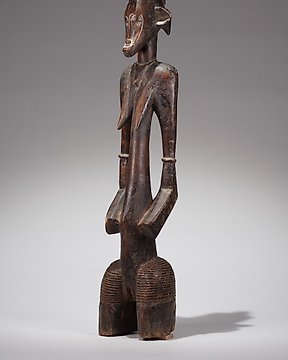
Senufo - Ivoorkust (Zonder Minimumprijs)
Nr. 84045579

Nr. 84045579

A Senufo Rhythm Pounder (Deble), Ivory Coast, depicting a tall female Deble sculpture, carved out of one piece of wood, the legs are coming out of the heavy rounded base, a thin outwardly curved abdomen, slender thin arms, hands in a fist position next to the stomach, the right hand is carrying an object, the shoulders are square, breasts pointing downwards, a strong neck carrying an oval shaped head, the face is finely carved, a small mouth at the end of a large jaw, elongated nose, half closed eyes and the hair is cut short and there is a chameleon standing on top of the head, with a long tail, the navel, breasts and the sides of the face are marked with carved scarifications, symbol of beauty and status; aged cracks, signs of use, glossy by use. Certificate of provenance.
“These large-scale statue are a very rare work of art among the Senufo, institutional style of professional sculpture, yet on some special occasions large works of art were commissioned by the male Poro society and also by their female counter equivalent society, the Tyekpa society. In the case of the Poro society, large statues of pairs were placed on public display near wooden shrines or shelters where the chosen society’s initiators gathered to celebrate and organize special events and funerals. The Poro society would commission statues such as this one to be carried and used in ritual processions or placed on the ground to serve as a focus point for the ceremonial dancers.
These statues might have also functioned as a large fetish figure or shrine-powered object to which ritual sacrifices were made on the statue. This type of sculpture was used in various ritual functions that would have taken place right before or after a Poro elder member died. The statue would have been carried by initiators of the Poro society who would visit the home of the deceased where sometimes the statue may have been placed beside the corpse of the deceased and covered in a shroud and shown to the public. The statue would then be carried in the funeral procession and accompanied the deceased to their burial place. There it was swung and pounded on the ground around the grave in a rhythmic manner in synchronized time to the music of the Poro society orchestra.
When the ceremony was complete and before nightfall, the grave was covered with soil as one of the Poro society’s members would perform the final gesture with the statue, leaping onto the grave and pounding the soil seven times. This pounding is to ensure that the spirit of the deceased person didn’t linger in the vicinity of the village compound.”
Source: Brauer Museum of Art.
Zo koop je op Catawiki
1. Ontdek iets bijzonders
2. Plaats het hoogste bod
3. Veilig betalen